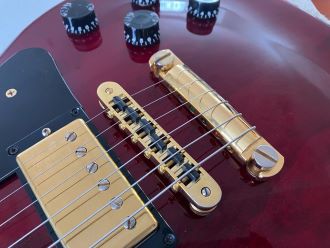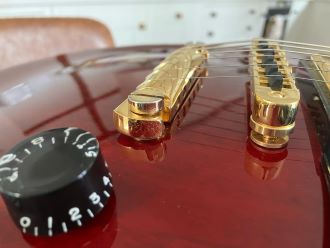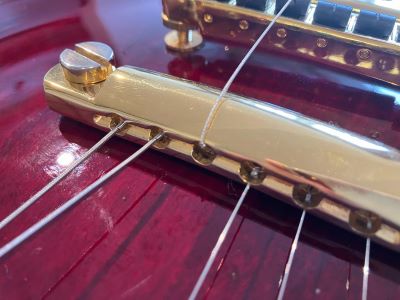‘Top wrapping’ a guitar
Top wrapping is a method of re-stringing a guitar in which the strings are threaded through the tailpiece ‘backwards’ (away from the bridge) and then bent back over the top of it towards the neck.
This involves setting the tailpiece height lower than normal: right down to the guitar body.
Top wrapping is most commonly seen on Gibson tune-o-matic bridges.
It is famously practised by a number of great guitarists including Joe Bonamassa, Billy Gibbons (ZZ Top), Duane Allman (Allman Brothers Band) and Jimmy Page (Led Zeppelin).

Advantages of top wrapping
First of all, top wrapping is fully reversible. It’s easy to revert to standard re-stringing methods if you’re unimpressed. So there’s no reason not to give it a go.
Second, top wrapping adds a little extra ‘slinkiness’ to the strings. This is because a top wrapped string results in a shallower string break angle over the saddle (see image). That means less downward pressure on the bridge making it easier to bend strings. Top wrapping can therefore be great for rock and blues styles.
Third, many players swear that top wrapping improves sustain and bass response (‘bottom end’). The theory behind this is that lowering the tailpiece so it’s in contact with the guitar body allows energy to flow more efficiently between the strings and the bridge and body. Makes sense in theory, right?

However, you need to decide for yourself whether top wrapping actually makes a difference to your instrument. A lot probably depends on your specific guitar, its wood and construction, your strings and their gauge, and your pickups. Next string change, try top wrapping: listen for any change in resonance or sustain and make up your own mind.

Disadvantages of top wrapping
There are very few reasons not to at least give top wrapping a try, given that it is easily reversible.
If you top wrap consistently, you will eventually start to see signs of wear on your tailpiece. This is unavoidable. However, you don’t really notice it when the strings are on so arguably it doesn’t ruin the aesthetic greatly. Indeed, for some, a little wear will add to the aesthetic!
Some players report more string breakages when top wrapping, due to the more severe bending of the string as it curves around the back of the tailpiece.
A final issue to be aware of is that the end of a string around the ball end is doubled back on and wrapped around itself. This ‘double wrapped’ portion of string can be difficult to bend around the back of the tailpiece, leaving a gap between the string and tailpiece that could impair tuning stability.
There is a ‘hack’ to avoid this which involves threading the ball end from an old string over your new string before fitting it (remove the old string first!). This lengthens the portion of string that passes through the tailpiece and prevents the double wound portion from reaching the ‘bend’. It’s not ideal but it works.

See our related post on setting tailpiece height for some additional considerations related to top wrapping.
ARE YOU An EMERGENCY WORKER
OR a STUDENT?
If so, we offer a generous discount.
See our community page to find out more.
